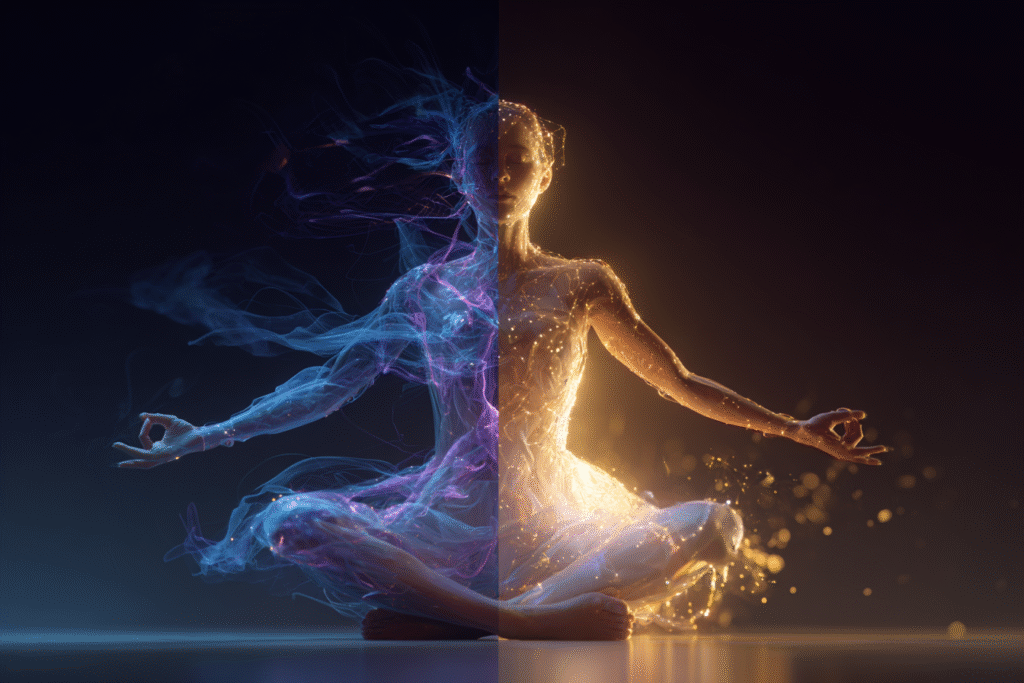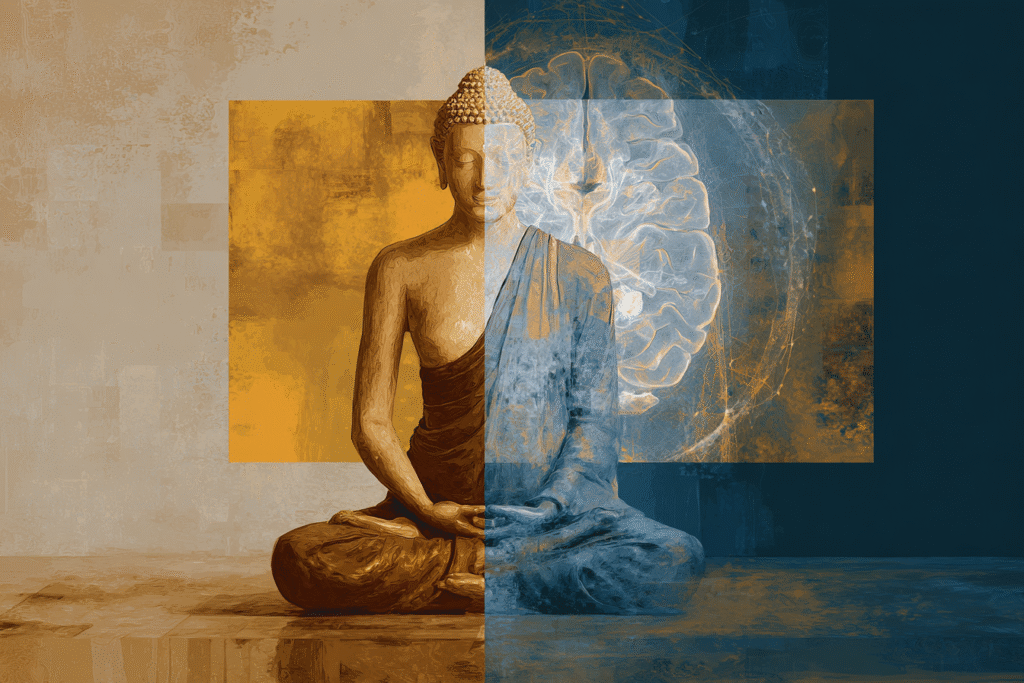What if every movement you make is quietly rewriting the way you experience reality?
Note: This article is for educational and informational purposes only. See full disclaimer at the end.
Every time you reach for your coffee, climb the stairs, or shift in your seat, you’re engaging in one of the most intricate conversations your body can have — where movement and consciousness don’t just coexist, they co-create each other.
This isn’t meditation rhetoric or abstract philosophy. It’s neuroscience — showing how movement patterns reshape consciousness, while awareness refines every motion you make.
The implications stretch far beyond fitness or physical therapy into the very nature of how you experience being alive.
The Movement-Consciousness Loop
Modern neuroscience has shattered the traditional view that consciousness sits in the brain directing movement like a puppet master controlling strings. Instead, research reveals something far more elegant: movement and consciousness exist as a dynamic communication channel that links the internal world in our minds to the physical world around us [1].
Science confirms this bidirectional relationship: movement emerges before consciousness in early development, while voluntary action later depends on conscious intention [2]. What results is a partnership where motion and awareness continuously shape one another.
Consider what happens 2–3 seconds before you decide to move. Your brain is already preparing for action — even before you’re consciously aware of the intention [3]. This doesn’t eliminate conscious control; it reveals it as a sophisticated filter that shapes how movement unfolds.
The practical implications are profound. When you understand this loop, every movement becomes an opportunity to enhance both physical coordination and conscious awareness simultaneously.

The Neuroscience of Intentional Movement
Recent research using advanced brain stimulation techniques has mapped exactly where movement intention emerges in consciousness.
Stimulating the right inferior parietal region triggered an urge to move the opposite hand, arm, or foot. Stimulating the left side sparked the intention to speak or move the lips [4].
This reveals something remarkable: the brain has a specific region where movement intention is born. The inferior parietal lobule acts as the bridge between abstract intention and concrete action, creating what researchers call “motor intention” before any actual movement occurs.
Here’s where it gets practical: by increasing neural excitability in the angular gyrus and motor cortex, researchers advanced the perceived timing of conscious intention by 60–70 milliseconds [4].
This suggests that conscious movement intention isn’t fixed—it can be enhanced and refined through practice.
Movement planning involves multiple brain regions working in synchrony. Neurons in the motor cortex fire before action begins — building a predictive model of how movement will feel and what it’s meant to accomplish.
Embodied Consciousness: When Body Becomes Mind
The relationship between movement and consciousness runs deeper than neural timing. Embodied cognition research shows that the mind emerges through the brain’s control of organized movement — turning abstract intention into physical reality [5].
This isn’t metaphorical. Embodiment makes your own and others’ minds as observable — and measurable — as any physical object [5]. Your conscious experience literally emerges from the way your brain processes movement, sensation, and spatial relationships.
Science shows that your sense of self depends on awareness of your body. How you pay attention to the body directly alters how you experience it — and ultimately, how you experience yourself [6].
This creates a fascinating opportunity: by changing how you move and pay attention to movement, you directly alter your conscious experience.
The body isn’t just a vessel for consciousness — it’s the soil it grows from.

The Interoceptive Foundation
At the heart of the movement-consciousness link is interoception — your ability to sense internal bodily signals. It’s how the brain integrates incoming data about your physiological state, producing the feeling states that underlie emotion and self-awareness [7].
Movement heightens interoceptive awareness. It’s about tuning into internal signals — your physiological rhythms, states, and subtle shifts in sensation [7].
This awareness fuels a continuous feedback loop between intention, action, and experience.
Specialized neurons called Von Economo neurons — found primarily in interoceptive circuits — help integrate emotion, action, and awareness in real time. These neurons fire during movement, uniting action and feeling.
The practical application is straightforward: the more attention you pay to internal sensations during movement, the more integrated your conscious experience becomes.
Movement with interoceptive awareness doesn’t just train your body—it trains consciousness itself.
Mindful Movement: Where Ancient Wisdom Meets Modern Science
Contemplative traditions have explored the link between movement and consciousness for millennia — and now, neuroscience is catching up. In a study of 670 participants, those who received mindfulness training were twice as likely to experience unity and disembodiment, with 43% reporting unity and 47% reporting blissful states [8].
These aren’t abstract spiritual experiences—they’re measurable changes in consciousness that occur when attention and movement are skillfully combined. The more people practiced mindfulness, the more likely they were to experience unity — where borders dissolve and perception becomes fully integrated — or disembodiment, a sensation of separation from the body.
These experiences activate key brain regions — including the anterior and posterior cingulate cortex, insula, and thalamus — all known to play central roles in consciousness and meditation.
These same regions are also activated during focused physical movement, suggesting that mindful motion and deep meditation may share neural architecture.
When you move mindfully — tracking sensations, intentions, and outcomes — you’re literally training the neural networks that create consciousness.

The Movement-Consciousness Training Protocol
Based on the research, here’s a systematic approach to developing the movement-consciousness connection:
Foundation Phase: Interoceptive Movement Awareness
Begin with simple movements while keeping your attention focused on internal bodily sensations:
Morning Activation (10 minutes)
- Gently rotate each joint while tuning into the quality of sensation in that area
- Walk slowly while noticing the shifting pressure patterns in your feet and legs
- Stretch gently and observe where ease gives way to resistance — without forcing past it
Key insight: physical movement naturally disrupts homeostasis — creating moments when internal awareness becomes easier to access [9].
Development Phase: Intentional Movement
Progress to exercises that emphasize the conscious intention-action connection:
Intentional Reach Protocol
- Before reaching for anything, pause and observe the spark of intention
- Feel into the moment just before movement — when intention is forming
- Execute the movement while maintaining awareness of both internal sensations and external effects
- Notice the completion moment when intention dissolves into accomplishment
Movement Prediction Training
- Move slowly and anticipate the sensation ahead of time
- Then compare it to what you actually feel
- Refine the prediction-sensation-awareness loop through repetition

Advanced Phase: Conscious Movement Integration
Integrate movement-consciousness training into daily activities:
Daily Life Applications
- Walk with awareness of your step rhythm and the shifting sensations in your body
- Eating with attention to the coordination of hand, mouth, and swallowing movements
- Typing or writing while tracking the interplay between mental intention and finger movements
The research supports this progression. Cognition involves an extended system assembled from brain, body, and environment, requiring new methods that focus on how agents assemble these resources into systems capable of solving problems.
What Changes When You Move Consciously
Practicing conscious movement leads to measurable changes in coordination, awareness, and perception. Research highlights several key benefits:
Enhanced Interoceptive Accuracy: Mindfulness practices improve both your interoceptive sensitivity and the brain’s neuroplasticity in these networks [6]. In simple terms: you become better at detecting internal signals that guide motion and decisions.
Improved Movement Prediction: The brain builds “forward models” to predict how movement will feel — and practice makes those models more accurate [1]. Conscious movement practice enhances these predictive models, leading to more fluid and efficient motion.
Expanded Conscious Awareness: Advanced movement-based meditation can trigger self-transcendence, mental clarity, and deep renewal — all linked to measurable shifts in brain activity.
Integrated Self-Experience: Tuning into your internal state in the present moment builds resilience, emotional regulation, and post-traumatic growth. Conscious movement becomes a pathway to deep self-integration and emotional healing.

Movement, Consciousness, and Life Quality
The movement-consciousness link extends far beyond personal training. Research shows that sensation and movement are dynamic, context-sensitive, and deeply tied to thought, emotion, and culture.
This means that how you move influences not just your physical health, but your emotional resilience, cognitive clarity, and social interactions. In social psychology, thoughts, feelings, and behavior are grounded in sensorimotor experiences and bodily states.
The implications for daily life are extensive:
Enhanced Decision-Making: As you become more attuned to your body’s signals, you strengthen access to “somatic markers” — internal cues that guide decisions before your mind begins to weigh them.
Improved Emotional Regulation: Conscious movement activates the same brain circuits that regulate emotion — offering a physical gateway to better mental health.
Increased Presence and Flow: The sustained attention required for conscious movement naturally strengthens present-moment awareness — the foundation of flow and peak performance.
Better Communication: Nonverbal synchrony — the way people move in tune with one another — happens naturally, often below conscious awareness. Conscious movement sharpens your ability to perceive and respond to these subtle cues.
The Future of Movement-Consciousness Integration
We’re at the beginning of understanding how movement and consciousness co-create each other. Advanced meditation research is now using seven-tesla MRI machines to map the entire brain at high resolution, revealing unique patterns of local activity during advanced states that differ from ordinary consciousness.

What this research makes clear is powerful: consciousness isn’t something that happens to you — it’s something you build through movement, attention, and sensation. Every gesture, every step, every reach becomes an opportunity to enhance the quality of conscious experience.
The practical applications are expanding rapidly. From rehabilitation protocols that use conscious movement to restore both physical and cognitive function, to performance training that enhances athletic and artistic achievement through movement-consciousness integration, to therapeutic approaches that use embodied awareness for emotional healing.
But perhaps most importantly for your daily life: understanding the movement-consciousness connection transforms every moment of physical activity from routine maintenance into conscious development.
Walking becomes meditation in motion. Exercise becomes training for consciousness.
Every gesture becomes an opportunity to deepen awareness and live with intention.
How you move shapes how you feel. And how consciously you move determines the depth of your presence. With every motion, you are — quite literally — constructing your reality.
It’s not a question of whether it’s happening — only whether you’ll shape it consciously.
See you in the next insight.
Comprehensive Medical Disclaimer: The insights, frameworks, and recommendations shared in this article are for educational and informational purposes only. They represent a synthesis of research, technology applications, and personal optimization strategies, not medical advice. Individual health needs vary significantly, and what works for one person may not be appropriate for another. Always consult with qualified healthcare professionals before making any significant changes to your lifestyle, nutrition, exercise routine, supplement regimen, or medical treatments. This content does not replace professional medical diagnosis, treatment, or care. If you have specific health concerns or conditions, seek guidance from licensed healthcare practitioners familiar with your individual circumstances.
References
The references below are organized by study type. Peer-reviewed research provides the primary evidence base, while systematic reviews synthesize findings across multiple studies for broader perspective.
Peer-Reviewed / Academic Sources
- [1] Churchland, M. M., & Shenoy, K. V. (2016). Movement: How the Brain Communicates with the World. Cell, 164(6), 1082-1093. https://pmc.ncbi.nlm.nih.gov/articles/PMC4818644/
- [2] Cebolla, A. M., & Cheron, G. (2019). Understanding Neural Oscillations in the Human Brain: From Movement to Consciousness and Vice Versa. Frontiers in Psychology, 10, 1745. https://www.frontiersin.org/articles/10.3389/fpsyg.2019.01930/full
- [3] Guggisberg, A. G., & Mottaz, A. (2013). Timing and awareness of movement decisions: Does consciousness really come too late? Frontiers in Human Neuroscience, 7, 385. https://www.frontiersin.org/articles/10.3389/fnhum.2013.00385/full
- [4] Desmurget, M., & Sirigu, A. (2009). Movement intention after parietal cortex stimulation in humans. Science, 324(5928), 811-813. https://www.science.org/doi/10.1126/science.1169896
Government / Institutional Sources
- [5] Stanford Encyclopedia of Philosophy. (2021). Embodied Cognition. https://plato.stanford.edu/entries/embodied-cognition/
- [6] Frontiers in Psychology. (2019). Mindfulness, Interoception, and the Body: A Contemporary Perspective. https://www.frontiersin.org/journals/psychology/articles/10.3389/fpsyg.2019.02012/full
Industry / Technology Sources
- [7] Khalsa, S. S., et al. (2018). Interoception and Mental Health: A Roadmap. Biological Psychiatry: Cognitive Neuroscience and Neuroimaging, 3(6), 501-513. https://www.sciencedirect.com/science/article/pii/S2451902217302343
- [8] University of Cambridge. (2024). Mindfulness training may lead to altered states of consciousness, study finds. https://www.cam.ac.uk/research/news/mindfulness-training-may-lead-to-altered-states-of-consciousness-study-finds
- [9] PMC. (2022). Interoception: A multi-sensory foundation of participation in daily life. https://pmc.ncbi.nlm.nih.gov/articles/PMC9220286/


